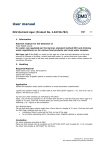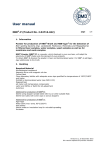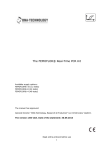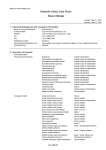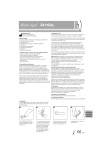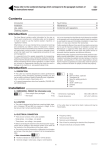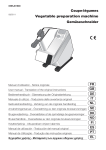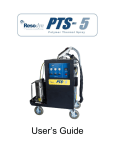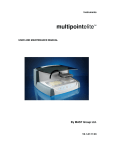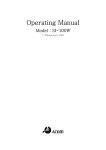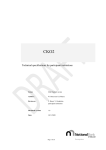Download User manual
Transcript
User manual page 1/4 NBB®-C (Product No.2.04711.782) ___________________________________________________________________________ 1. Information Concentrated nutrient medium for the trace detection and enrichment of Beer-spoiling microorganisms (esp. Lactobacilli, Pediococci, Pectinatus and Megasphaera) in samples of filtered and unfiltered beer e.g. in gore samples or bottled beer. NBB®-Concentrate (NBB®-C) (pH 6.5 ± 0.3) is a ready-to-use concentrated broth for a fast and safe detection of beer spoiling microorganisms in the brewing industry. Due to the selectivity of the NBB®-media the harmless accompanying flora as the contained yeast will be inhibited while beer spoilers are supported by a special growth component. By diluting with sterile water and beer, the selectivity of NBB®-C can be adjusted depending on the microbial spectrum, which you want to detect. The NBB®-C is designed for the microbiological examination of turbid beer samples as green and unfiltered beer, for yeast samples, as an additive in shelf life tests and also as an enrichment media for microbiological methods (PCR, VIT). 2. Handling Required Material Microbiological workbench Sterile swing stopper sample bottle (180 mL) or other suitable flasks Sterile test tubes with screw caps or porous stoppers Incubator Application Handle the samples under sterile conditions to avoid secondary contamination. For the examination of turbid beer samples use sterile swing stopper sample bottles or other suitable flasks. Always use NBB®-C with beer, as otherwise no beer-specific selectivity is given. Add 5% of NBB®-C (9 mL) of the total volume (180 mL) to your sample (170 mL), collected in a 180 mL sterile swing stopper sample bottle or other suitable flask. By diluting the beer with sterile water up to the bottle edge, the selectivity of the nutrient media can be steered individually (Fig.1). For the detection of indicator germs add approx. 25 % sterile water (45 mL) to your sample so that the bottle contains air. Version 4.0, 19 June 2015 this version replaces all previous versions. User manual page 2/4 NBB®-C (Product No.2.04711.782) ___________________________________________________________________________ Fig. 1 Selective detection of beer-spoiling bacteria corresponding to their harmfulness. The yeast inhibitor was selected to operate after a short initial period, time enough for the yeast to start fermentation and create a CO2-atmosphere, to be inhibited. Due to this short initial fermentation step at the beginning of the cultivation of the yeast, the swing stopper or cap of the bottle should not initially be sealed. For the shelf life test of your filled bottles add 3-7% NBB®-C as an additive to the beer and fill the bottle up to the edge. Use a swing stopper or cap of the bottle to seal the bottle. Incubation Incubate the test samples in swing stopper sample bottles (180 mL) or other suitable flasks for a minimum of 7 and a maximum of 14 days at 26-28°C/79-82°F. Conduct the shelf life test as usually. Incubate the yeast samples for 5 days at 26-28°C/79-82°F. An anaerobic incubation is not required, since the initial fermentation step of yeast in the beginning is already creating air-free conditions in the sample vessel. For further use as an enrichment media for NBB®-A; NBB®-B or molecular biological methods (VIR, PCR) an incubation time of 2 days in NBB®-C may be sufficient. Version 4.0, 19 June 2015 this version replaces all previous versions. User manual page 3/4 NBB®-C (Product No.2.04711.782) ___________________________________________________________________________ Evaluation Since the speed of the microbial growth depends on several factors (initial cell count, type, physiological condition and origin of the germs, degree of adaptation to beer), an incubation time of one day may be sufficient, in case of high contaminations, to obtain a result. Mostly several days are needed in case of trace contaminations or of very slow growing strains (e.g. Lactobacillus lindneri). Observe the growth-pattern during incubation time to obtain clear results about the condition of your sample. Evaluate the yeast samples after 5 days and the beer test samples after 7 days of incubation for a final comparability of your results. A macroscopic analysis of the results can be made if there is a clearly increase of the sample turbidity. Due to the lack of indicator there is no colour change, red to yellow, as a result of contamination as known from the other NBB® products. For final results a microscopic evaluation of the sample is necessary. Due to the presence of dead or harmful microorganisms the amount of microorganisms should be noticeably more than 1 in 10 microscopic fields at a 600-fold microscopic magnification. In doubtful instances it is again advisable to carry out an additional enrichment in NBB®-B. 3. Storage and Packaging Information Packaging and Content unit unit size (Box) unit gross weight (Box) Cardboard Box (9x250 mL in glass bottles) approx. 22 cm x 22 cm x 18 cm / 8.7 in x 8.7 in x 7.1 in approx. 4.1 kg/ 9 lbs. Storage Store at 4-8°C/40-46°F according to product specification. Store under dry and dark conditions. Do not freeze product. Waste Disposal No dangerous good. No hazardous material. Please consider your local waste regulations. Not inoculated concentrate can be disposed with normal laboratory waste. Inoculated and incubated samples are to be sterilized before disposal at a temperature of 121°C/ 250°F for 20 min. Warnings Do not cook or freeze product. Version 4.0, 19 June 2015 this version replaces all previous versions. User manual page 4/4 NBB®-C (Product No.2.04711.782) ___________________________________________________________________________ 4. Related products Version 4.0, 19 June 2015 this version replaces all previous versions.






